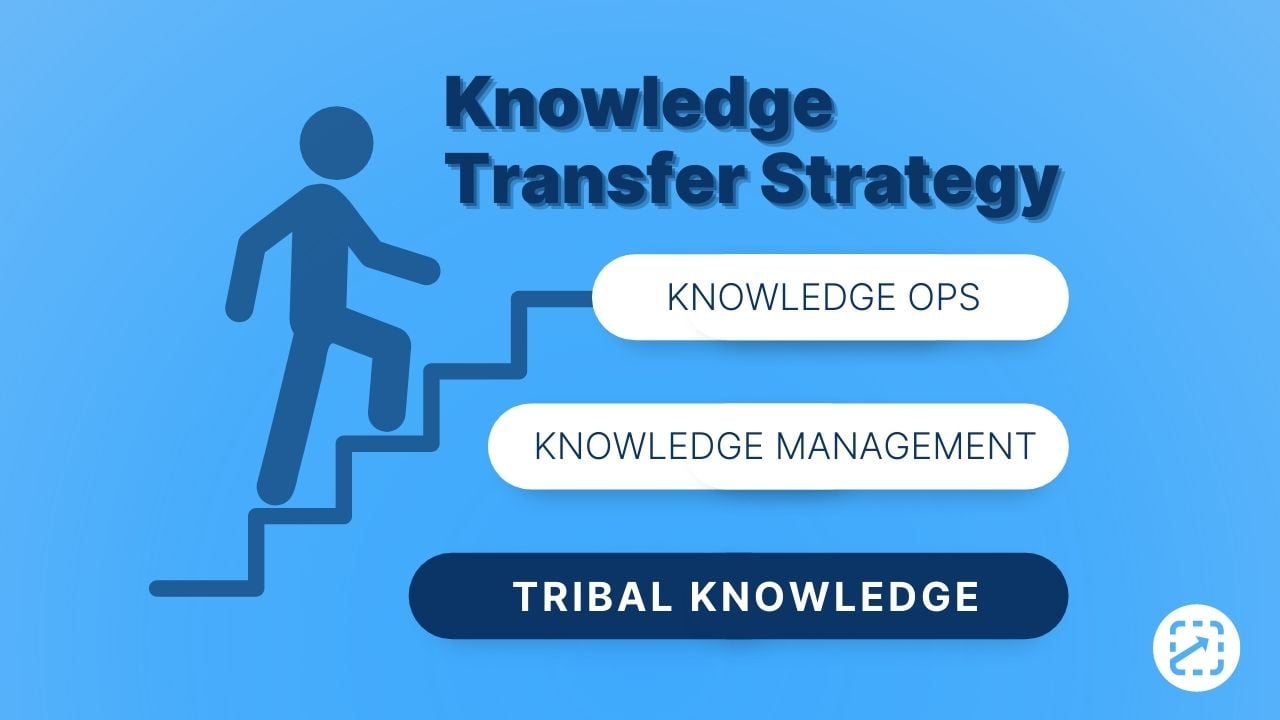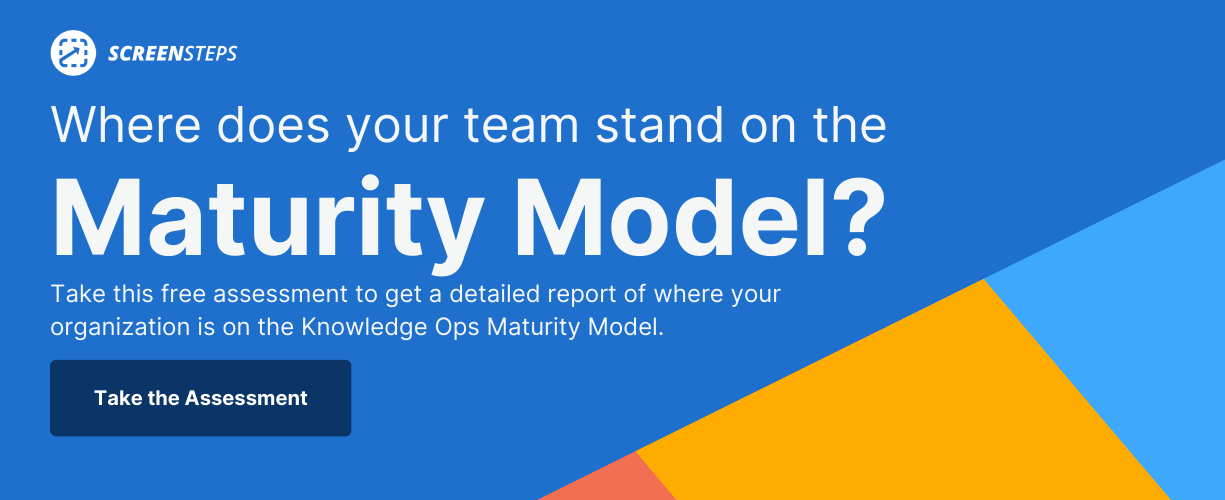Knowledge Transfer Plan: 3 Different Strategies
What is the best way to transfer knowledge to your employees?
Companies use many different strategies to teach employees the information they need to know to do their jobs — but not all strategies are effective.
Often, new hires finish training and still don’t know how to do their jobs. Some businesses take 12-18 months until employees are proficient at their jobs and can work independently.
Working for ScreenSteps — a knowledge ops solution — we have many businesses that come to us thinking they have a learning problem or that their employees aren’t cut out for their jobs. But, what they eventually realize is that the company has a knowledge transfer problem.
A knowledge transfer problem is solved by getting the right knowledge transfer strategy in place.
Here are three different levels of knowledge transfer plans. Each of these will help improve your knowledge transfer approach in your company but with varying results. Read about each below to figure out which is the best solution for your business.

1. Tribal knowledge plan
A tribal knowledge strategy involves information that is stored in your experts’ heads. It is an informal or passive approach to transferring knowledge.
Typically, the information isn’t documented anywhere. Or, if it is documented, it isn’t formalized.
Tribal knowledge is the lowest level of a knowledge transfer plan.
Purpose
As a knowledge transfer strategy, tribal knowledge is meant to help employees get things done.
Ultimately, the goal of tribal knowledge is to preserve the critical information in a company. It is to ensure that knowledge is passed on within your organization.
However, a tribal knowledge approach tends to be more about survival. The hope is that employees have learned enough to not have to ask others too many questions and so they can get things done on time.
Strategy approach
A tribal knowledge plan is to have supervisors available to answer employee questions. This means having a lower ratio of employees to supervisors.
These are typically one-on-one interactions whether those are in-person via word-of-mouth, in a chat message, or over email.
In a way, a tribal knowledge transfer plan is like an extended shadowing and nesting phase. The difference is that the nesting phase never ends. Employees are constantly dependent on supervisors and co-workers for answers to questions they don’t know the answer to.
Challenges and weaknesses
Tribal knowledge is difficult to track. Not to mention, tribal knowledge is fleeting.
When you rely on a specific employee to know something, what happens to that knowledge if the employee quit one day?
Ultimately, a tribal knowledge strategy is unstable and unreliable.
Advantages
The only advantage to tribal knowledge is it happens naturally and takes little to no work upfront.
With that being said, you might not have work upfront, but that means you have a ton of work in your day-to-day operations as your supervisors dedicate their time to answering questions.
2. Knowledge management strategy
A knowledge management strategy involves collecting, creating, organizing, and sharing information in an organization.
Knowledge management is information-centric, meaning it focuses on capturing knowledge and making sure materials exist.
Like with tribal knowledge, your knowledge management strategy only takes care of the operations side of knowledge transfer.
Purpose
The primary purpose of a knowledge management strategy is to document how things are supposed to be done.
You do that by getting the information out of your experts’ heads. Essentially, you are collecting all of the information into a centralized hub. You document the policies and procedures. Often, this results in an online manual.
The goal is to collect information and write it down so that your business can pass quality assurance and compliance audits as well as pass on information to employees.
It also ensures that information survives if an employee leaves or the information is lost another way.
Strategy approach
To execute a knowledge management strategy, you need knowledge management software. This could be document management software, knowledge base software, or another document sharing software.
The point of your software is to create a centralized hub where you can create, organize, store, and share your information with employees.
Often, companies dump all of their information in their knowledge management software without thinking about how employees will use that information.
However, if the knowledge management software isn’t up to par or the employees don’t use it, then the company still defaults to a tribal knowledge approach for transferring knowledge.
Challenges and weaknesses
While you share the documented files with employees via a shared drive, knowledge base, or similar software, the guides aren’t easy for employees to follow.
That’s because with knowledge management the focus is on capturing the knowledge — not making the guides usable. Often, employees don’t end up using the guides that were created because they are too difficult to understand.
It’s difficult to adapt to change. Information easily becomes outdated because there is no plan for optimizing and updating articles.
Advantages
With a knowledge management strategy, you at least have your policies and procedures written down. And another advantage is you have them stored in a centralized location.
This impacts your ability to pass audits, but it doesn’t really have an impact on employee performance and operations.
3. Knowledge ops strategy
A knowledge ops strategy is a big-picture look at transferring knowledge. It is one cohesive plan that covers both your operations and training portions of your knowledge transfer plan.
Knowledge ops is end-user-centric, meaning it focuses on supporting employees so they can work confidently and independently.
The elements of a knowledge ops plan include the same parts of a knowledge management strategy. A knowledge ops strategy helps you capture, create, organize, store, and share knowledge. Additionally, it provides frameworks to help onboard and train employees.
Purpose
The primary purpose of a knowledge ops strategy is to help employees DO something. By that, we mean that it helps employees handle different procedures and situations independently on the job. A knowledge ops strategy is action and outcome-focused.
Like knowledge management, it helps you capture your knowledge. However, the difference is that you are not just writing policies and procedures down.
You write them with the intent that employees will use the guides every time they perform a procedure, so you write clear instructions and leave out excess information.
So, you are once again getting the information out of your experts’ heads, but you are also creating an action that any employee can repeat.
Strategy approach
Knowledge operations is a combination of technologies and habits that allow employees to work without needing assistance from supervisors and SMEs.
When you use a knowledge ops strategy, the line between training and operations gets blurred. That’s because you align your operations and training teams to create one cohesive knowledge transfer strategy.
Digital guides and a centralized knowledge hub are the key components of a knowledge ops strategy.
You create digital guides that employees can use every time they handle different procedures and tasks for their jobs.
You use those guides from the first day of training throughout the job. So, from the get-go, employees are practicing doing what they will be doing every day in their jobs.
Challenges and weaknesses
Building a knowledge ops strategy takes a lot of work upfront. However, once you have created the digital guides and launched your strategy, the ROI is immediate.
Advantages
Your operations and training teams are aligned. This means employees are taught one way to do something and that carries over into their jobs.
The result is more consistent performance, fewer mistakes, and improved employee confidence and independence.
One bonus is that a knowledge ops strategy also includes a strategy for employee training.
Determine how mature your knowledge transfer strategy is
While you choose between any of these knowledge transfer plans to improve your knowledge operations, only one will get you faster training, better performance scores, and fewer mistakes.
ScreenSteps provides a knowledge ops platform (similar to a knowledge base), Find & Follow Framework, and coaching services to help you get your business operations working the way you need them to.
What is the state of your current knowledge transfer strategy? How are your business’s knowledge operations?
Take our free Knowledge Ops Maturity Grader. This self-evaluation helps you identify how mature your knowledge ops is and helps you determine how you can improve.




